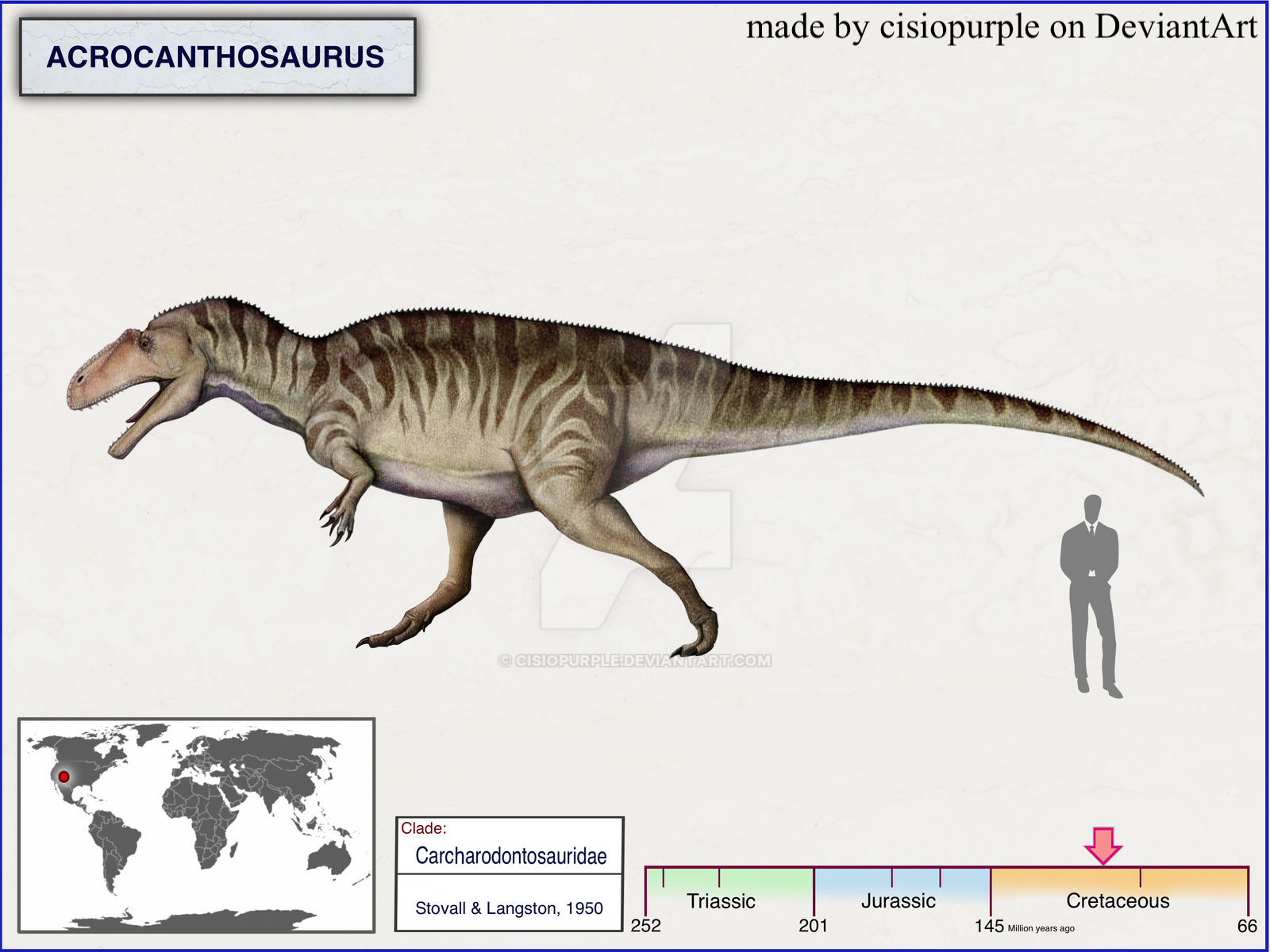Welcome to Acrocanthosaurus

Name Definition
High spined lizard
Name Given By
Stovall & Langston, 1950
Location
Antlers Formation in Oklahoma, Twin Mountains Formation in Texas, Cloverly Formation in the western United States, and maybe in the Arundel Formation of Maryland far up east in the U.S.
Classification
Dinosauria, Saurischia, Theropoda, Carnosauria, Carcharodontosauridae
Size
about 3.5 meters tall, around 11 meters long, 6.5 - 7 tons
Temporal Range
Aptian - Albian stages of the early Cretaceous, 116 - 110 million years ago
Ecological niche
apex predator
Species/Sub Species
A. atokensis
Diet
as apex predator, Acrocanthosaurus had a wide variety of food sources ranging from the mid-sized ornithopods like Tenontosaurus all the way to hunting sauropods like Astrodon and Sauroposeidon as well as ankylosaurs like Sauropelta
Introduction
Acrocanthosaurus is a genus of carcharodontosaurid theropods that lived in the U.S during the early Cretaceous. Acrocanthosaurus means "high -spined lizard" which is in reference to its elongated neural spines found on many of its dorsal vertebrae, giving it a fleshy sail-like structure on its back. The species name atokensis is in reference to Atoka County in Oklahoma where the original specimens of Acrocanthosaurus were found.
Acrocanthosaurus can be easily recognized by the high neural spines that run from the nape of the neck to the tip of the tail. Many scientists speculate that these high dorsal spines may have supported a sail-like flap of skin which is seen often in most paleoart, similar to some spinosaurids. The purpose for this sail like structure is still being debated. Some think that it would provide a larger surface area which would help with temperature exchange and reduce the negative effects of gigantothermy like detriments to muscle endurance. Another possibility is that the sail could have been composed of fatty tissue which would help it endure through extended periods of time without eating. This sail may have also been a visual indicator on how healthy an individual was, and the more colorful it was, the more healthy an individual is. However, the sail could have served more than one purpose. It could help eat a minimum amount of food while still maintaining a large and healthy sail. This sail color could also help in battles for dominance. The larger the sail is, the more capable of hunting an individual is. The Acrocanthosaurus with the smaller sail would probably back away from the more powerful individual which is indicated by its sail.
Acrocanthosaurus was one of the biggest theropods of its time which is seen in some other carcharodontosaurids, the large shark toothed carnosaurs like Giganotosaurus and Carcharodontosaurus that reigned before the tyrannosaurids, though Acrocanthosaurus lived much earlier than the other 2 genera. Acrocanthosaurus would have definitely been the largest predator in its environment and thus was capable of hunting a variety of dinosaurs including Tenontosaurus, the resident ornithopod of the Antlers Formation, as well as sauropods like Astrodon and Sauroposeidon, which were enough to sustain Acrocanthosaurus for a long time and were also too slow to escape the large sauropod butcher. Being the largest predator, Acrocanthosaurus could also sustain itself by stealing kills made by other smaller predators like the dromaeosaurid Deinonychus.
As shown in the remains, Acrocanthosaurus’ skull possessed relatively large fenestra, a feature that would have been vital to reducing the weight of its head that was about 130 cm long. Looking further into the skull, Acrocanthosaurus’ teeth are curved and serrated like most family members of the Carcharodontosauridae, and the maxilla and premaxilla consist 38 in total of these blade-like teeth. The teeth on the lower jaw tend to be smaller than the ones on the upper jaw. Another common carcharodontosaurid feature that is present in Acrocanthosaurus is a bony ridge situated above the eye. This ridge is formed by the lacrimal postorbital bones (both are bones that are part of the eye socket). Computer reconstruction of the inner ear canal has shown that the pose the head of Acrocanthosaurus is usually in is somewhere around 25º below a completely horizontal pose. Looking from the side, this would probably make Acrocanthosaurus look like it was slightly looking towards the ground whenever it was walking around. Computer reconstruction of the forelimbs or arms of Acrocanthosaurus show that there was probably a large amount of cartilage between the bones. This is due to the fact that the bones in the forelimbs cannot make perfect joints themselves, so the cartilage would have to help articulate the joints in order to make the arms function properly. Even with this, Acrocanthosaurus’ arms only had a limited range of motion. The arms could not extend completely outward and were limited to some extent. The first and second digits on the hands were permanently bent while the third digit may have been able to move a bit more. However, Acrocanthosaurus may have been able to use its arms to grab prey after its jaws were secured around the prey. The cervical vertebrae (neck vertebrae) was also interlocked for more rigidity which means that the neck of Acrocanthosaurus was more rigid and would have had a firm grip without any injury when holding onto prey. Smaller prey like Tenontosaurus would have been pulled forwards with Acrocanthosaurus’ arms while it finished it off with its jaw. Contrary to the last hunting method, Acrocanthosaurus could instead hold onto prey with its jaws while slashing with its small arms, making the prey struggle more and intensify its wounds.